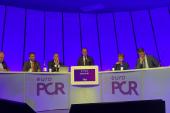Same-Day Discharge Possible After Many Percutaneous CV Procedures: Review
To be successful, patients and their caregivers must be on board and protocols must be established to ensure safety.

Same-day discharge (SDD) is an option after many elective transcatheter cardiovascular interventions—not just PCI or even TAVI, but also others—provided that patients and families are on board, no complications occur that require extended monitoring, and the proper protocols are in place for ensuring safety, according to a review article.
Amar Krishnaswamy, MD (Cleveland Clinic, OH), lead author of the paper, published online yesterday in JACC: Cardiovascular Interventions, said it emerged from the Cleveland Clinic’s own firsthand experience.
“At the beginning of the COVID pandemic, in the early part of 2020, as a lot of hospitals were trying to figure out ways that they could get their patients treated within the confines of limited staffing and limited bed availability and personnel availability in hospitals, we started looking at ways in which we could streamline our process for treating patients with aortic stenosis with TAVR,” he told TCTMD.
During this time, they and others showed SDD post-TAVI could be done safely and is feasible. They soon realized that there was evidence supporting a same-day time frame for a broader swath of elective transcatheter procedures.
For patients, a visit to the hospital can sometimes be detrimental, said Krishnaswamy. “[This] is not to say that we don't take great care in hospitals, but sometimes the longer patients stay, the higher risk they're at for nosocomial infections. We know, especially as patients get older, and those are often the patients we treat with transcatheter cardiovascular procedures, that the risk of delirium increases the longer patients stay and delirium in and of itself leads to worse functional outcomes and increased risks of mortality.”
The review adds another benefit to the list: “Shorter length of hospital stay can effect cost reduction by decreasing ‘routine’ testing and optimizing the use of limited healthcare resources, including space and personnel.”
Thus, processes that enable patients to be discharged sooner—as long as it’s safe—can go a long way toward better care, Krishnaswamy et al stress.
Their review covers the evidence on procedures, like PCI and, more recently, TAVI, for which SDD is more widely accepted as possible, as well as what’s known about other structural heart and peripheral vascular interventions, where the knowledge base is growing.
“As with anything in medicine, we all just get used to doing things the way that we do them. Our hope in publishing this paper is to make people think a little bit more about their treatment pathways and algorithms for discharge and see whether they might be able to apply these kinds of processes in their systems,” said Krishnaswamy.
For PCI, the literature on SDD goes back two decades, though even today only about 20% to 25% of patients follow this path, he noted. A few years ago, the Cleveland Clinic had an SDD rate of around 10% to 15%. With new protocols in place, this rate has risen to almost 60%. With TAVI, the Cleveland Clinic’s rate started out at 22% and has risen to around 40%.
Building the Foundation
The review emphasizes three “basic tenets” behind a same-day approach.
“The first step is to set the expectations of patients and families by informing them of the possibility of SDD to prepare mentally and facilitate logistical planning,” the authors note. Not all patients and families are initially okay with the idea, said Krishnaswamy, “so the most-important [thing] is that everyone has bought into the concept and understands that it's a safe thing to do.”
On an institutional level, “the second step is the creation of guidelines for patient selection. This advance planning also helps caregivers to schedule eligible patients’ procedures at a time that ensures adequate postprocedural observation,” the review explains.
Krishnaswamy said that the decision to discharge someone on the same day doesn’t depend on things like a patient’s age or the complexity of the case. Rather, “as long as the procedure is completed without a complication that requires further hospital observation, those patients are great candidates for a same-day discharge,” he said. It’s important to clearly define what’s considered “uncomplicated” for each particular type of procedure, the review specifies. Typically, complicated procedures involve vascular access-related issues, stroke, or other embolic sequelae, though there can be issues specific to certain interventions.
“The final step,” according to the paper, “is to make sure that the postprocedural assessment adequately allows the identification of potential complications or need for extended observation.” Patients should have support systems in place, the authors stress, as well as instructions on what to watch out for and how to react to any problems that arise.
For some types of procedures, such as PCI or peripheral vascular interventions, delayed complications are rare. For structural heart procedures, where there can be things like conduction system disturbances, more monitoring is required: as part of the pathway at the Cleveland Clinic, Krishnaswamy said, patients have a scheduled visit with an advanced practice provider within 1 to 2 days after they leave the hospital.
Individual operators and centers really need to be well aware of their own personal outcomes when embarking on earlier discharge protocols, because we know that there is such variability. Amar Krishnaswamy
Krishnaswamy highlighted structural heart interventions as an area where more study is needed. “The volume of structural procedures, the breadth of structural disease that we can treat percutaneously, is really increasing at a tremendous rate. And so I think that’s where the most-significant paucity of data exists to say that early discharge, and same-day discharge specifically, is safe and can be employed,” he suggested. Research should look into whether there are differences across centers that could influence elements of safety, like complication rates, which should inform decision-making around SDD.
What can’t be forgotten in the quest for streamlined care is quality, Krishnaswamy stressed.
“Individual operators and centers really need to be well aware of their own personal outcomes when embarking on earlier discharge protocols, because we know that there is such variability,” he explained. “Sites that might either have a low volume of a certain procedure or who may have a higher rate of complications, such as femoral vascular complications with PCI or pacemaker implantation rates after TAVR, . . . . these may not be the best [places] to employ an early discharge pathway like this.”
The review authors advise that clinicians and health systems should prioritize assessing quality metrics on a regular basis, in order to confirm that SDD patients don’t face increased risks. “In addition to routine procedural outcomes (mortality, stroke, etc), consideration should be given to rates of hospital readmission (especially in the near term), adherence to guideline-directed medical therapy, and any other procedure-specific metrics that may suffer because of early discharge,” they say.
Caitlin E. Cox is News Editor of TCTMD and Associate Director, Editorial Content at the Cardiovascular Research Foundation. She produces the…
Read Full BioSources
Krishnaswamy A, Isogai T, Brilakis ES, et al. Same-day discharge after elective percutaneous transcatheter cardiovascular interventions. J Am Coll Cardiol Intv. 2023;16:1561-1578.
Disclosures
- Krishnaswamy reports no relevant conflicts of interest.





Comments